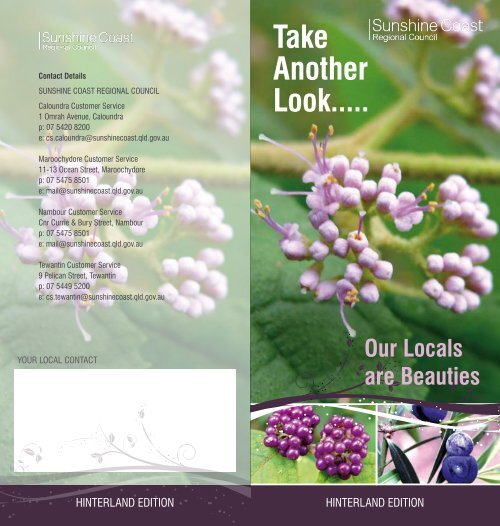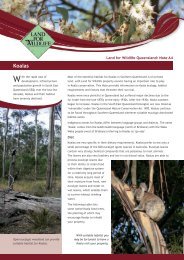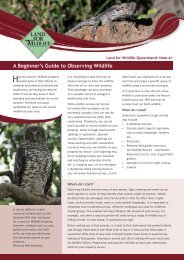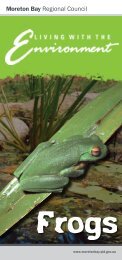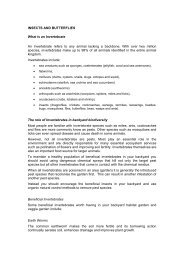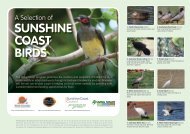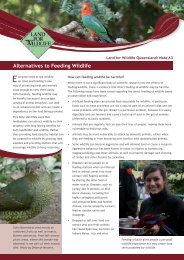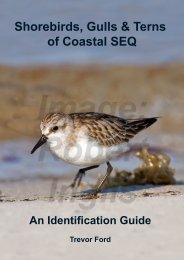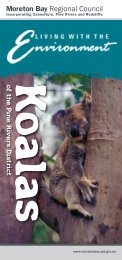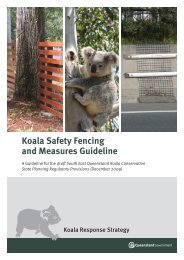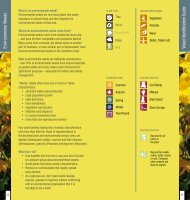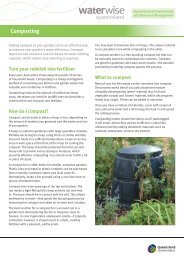Our Locals Are Beauties - Sunshine Coast Council
Our Locals Are Beauties - Sunshine Coast Council
Our Locals Are Beauties - Sunshine Coast Council
You also want an ePaper? Increase the reach of your titles
YUMPU automatically turns print PDFs into web optimized ePapers that Google loves.
Contact Details<br />
SUNSHINE COAST REGIONAL COUNCIL<br />
Caloundra Customer Service<br />
1 Omrah Avenue, Caloundra<br />
p: 07 5420 8200<br />
e: cs.caloundra@sunshinecoast.qld.gov.au<br />
Take<br />
Another<br />
Look.....<br />
FRONT<br />
Maroochydore Customer Service<br />
11-13 Ocean Street, Maroochydore<br />
p: 07 5475 8501<br />
e: mail@sunshinecoast.qld.gov.au<br />
Nambour Customer Service<br />
Cnr Currie & Bury Street, Nambour<br />
p: 07 5475 8501<br />
e: mail@sunshinecoast.qld.gov.au<br />
Tewantin Customer Service<br />
9 Pelican Street, Tewantin<br />
p: 07 5449 5200<br />
e: cs.tewantin@sunshinecoast.qld.gov.au<br />
YOUR LOCAL CONTACT<br />
<strong>Our</strong> <strong>Locals</strong><br />
are <strong>Beauties</strong><br />
HINTERLAND EDITION<br />
HINTERLAND EDITION<br />
0
Table of Contents<br />
Local native plant guide<br />
2<br />
Introduction<br />
3<br />
Native plants<br />
4 - 41<br />
Wildlife Gardening<br />
20 - 21<br />
Conservation Partnerships<br />
31<br />
Environmental weeds<br />
42 - 73<br />
Method of removal<br />
43<br />
Succulent plants and cacti<br />
62<br />
Water weeds<br />
70 - 71<br />
References and further reading<br />
74<br />
PLANT TYPE<br />
ENVIRONMENTAL BENEFITS<br />
What you grow in your garden can have major impact,<br />
for better or worse, on the biodiversity of the <strong>Sunshine</strong><br />
<strong>Coast</strong>. Growing a variety of native plants on your<br />
property can help to attract a wide range of beautiful<br />
native birds and animals. Native plants provide food and<br />
shelter for wildlife, help to conserve local species and<br />
enable birds and animals to move through the landscape.<br />
Choosing species which flower and fruit in different<br />
seasons, produce different types of fruit and provide<br />
roost or shelter sites for birds, frogs and lizards can<br />
greatly increase your garden’s real estate value for native<br />
fauna. You and your family will benefit from the natural<br />
pest control, life and colour that these residents and<br />
visitors provide – free of charge!<br />
Introduction<br />
Local Native Plants<br />
Tall Palm/Treefern<br />
Tree<br />
Shrub<br />
Groundcover<br />
Grass<br />
Vine<br />
Habitat for native frogs<br />
Attracts native insects<br />
Attracts native birds<br />
Suitable for planting near<br />
powerlines<br />
Local native plants also improve our quality of life in<br />
other ways. They create privacy and shade, protect<br />
from extremes of weather and stabilise slopes, thereby<br />
reducing soil erosion and helping to improve water<br />
quality.<br />
Plants from elsewhere in the world or even other parts<br />
of Australia can have a number of negative impacts<br />
on the local environment. Some are invasive weeds<br />
which displace local native species and reduce diversity<br />
of species and habitats. Others are toxic to native<br />
fauna, diminish water quality and can even change soil<br />
chemistry and structure.<br />
PLANT TYPE FORMS<br />
TT Tall tree (>25m)<br />
MT Medium tree (15-25m)<br />
ST Small tree (5-15m)<br />
TS Tall shrub (>5m)<br />
MS Medium shrub (2-5m)<br />
SS Small shrub (0-2m)<br />
In the latter part of this booklet, you’ll meet some of the<br />
‘garden thugs’ – garden plants which, like human thugs,<br />
behave themselves when you keep an eye on them but<br />
‘jump the fence’ if allowed to get out of control. They do<br />
this by enticing birds to eat their fruit and carry the seeds<br />
into bushland. Worse still, irresponsible gardeners dump<br />
garden waste over the fence or on roadsides allowing<br />
these thugs to bully our native plants out of their homes.<br />
You may be surprised to know that of all the weeds in<br />
Australia, two thirds are escaped garden plants!<br />
So – take another look – our locals are beauties. Plant<br />
them in your garden and help to keep the <strong>Sunshine</strong> <strong>Coast</strong><br />
a special place.
Palm/Treefern<br />
Piccabeen palm<br />
Archontophoenix<br />
cunninghamiana<br />
A self cleaning palm<br />
which is closely related<br />
to the widely cultivated<br />
Alexandra palm. A very<br />
neat palm which attracts<br />
a wide variety of wildlife<br />
when fruiting, eg fruit<br />
doves, parrots. Excellent<br />
for wet position and a<br />
good replacement for the<br />
weedy Cocos or Queen<br />
palm. Leaves provide<br />
food for palm<br />
dart butterflies.<br />
Prickly treefern<br />
Cyathea leichhardtiana<br />
A slender treefern that<br />
requires shade and ample<br />
moisture. The trunk<br />
and base of the fronds<br />
are covered with short<br />
sharp prickles. Resents<br />
disturbance.<br />
Palm/Treefern<br />
Images courtesy of Sue Aspland<br />
Image courtesy of Sue Aspland<br />
Straw treefern<br />
Cyathea cooperi<br />
A handsome treefern for<br />
a sheltered, frost free<br />
position. The trunk is very<br />
decorative with oval scars<br />
left by the shed fronds.<br />
The developing fronds are<br />
covered in long golden<br />
scales. Choose location<br />
carefully as it produces<br />
masses of spore which<br />
can be a nuisance inside<br />
houses or in water tanks.<br />
Cabbage tree palm<br />
Livistona australis<br />
A good substitute for the<br />
introduced Fan Palm in<br />
larger gardens. The fronds<br />
have numerous spines<br />
along the stems so this<br />
palm should not be planted<br />
close to paths or lawn<br />
areas.<br />
Image courtesy of Sue Aspland<br />
Image courtesy of Sue Aspland
Tree<br />
Jackwood<br />
Cryptocarya glaucescens<br />
Brown pine<br />
Podocarpus elatus<br />
Tree<br />
A handsome native laurel<br />
for good soils. Large,<br />
glossy green leaves<br />
have an attractive silvery<br />
reverse. Excellent for<br />
attracting native fauna<br />
including king parrots<br />
and white headed<br />
pigeons. Leaves provide<br />
food for larvae of<br />
orchard, blue triangle,<br />
bronze flat and Macleay’s<br />
swallowtail butterflies.<br />
An outstanding shade<br />
tree for larger gardens.<br />
Hardy tree with decorative<br />
glossy leaves and purple<br />
fruit, the swollen stalk of<br />
which is edible. Belongs<br />
to a group of very ancient<br />
plants. Large specimens<br />
develop attractive flaky<br />
grey bark. Fruit is<br />
attractive to many native<br />
birds.<br />
Image courtesy of Glenn Leiper<br />
TT<br />
Images courtesy of Glenn Leiper<br />
TT<br />
Riberry<br />
Syzygium leuhmannii<br />
Beautiful flushes of pink<br />
new growth and edible<br />
pink-red fruits in Summer<br />
make this a desirable tree<br />
for a large yard. Tends<br />
to form a compact tree<br />
when grown in the open<br />
and can be pruned to<br />
form a hedge. Fruit<br />
is eaten by many bird<br />
species.<br />
Black she-oak<br />
Allocasuarina littoralis (featured)<br />
Forest oak<br />
Allocasuarina torulosa<br />
A very attractive tree with<br />
fine ‘foliage’ and corky<br />
bark. Some forms have<br />
weeping foliage. Requires<br />
good soil and drainage.<br />
Black sheoak is a hardy<br />
species suitable for poor<br />
soils. Crown is more open<br />
than forest oak. Both<br />
species are an important<br />
food source of Glossy<br />
black cockatoos.<br />
Images courtesy of Sue Aspland<br />
TT<br />
Image courtesy of Sue Aspland<br />
TT
Tree<br />
Lillypilly<br />
Acmena smithii<br />
White hollywood<br />
Auranticarpa rhombifolia<br />
Tree<br />
A variable species,<br />
available as a smallleaved<br />
form (‘var. minor’)<br />
which is a tall shrub or<br />
the large- leaved form<br />
which is a medium<br />
tree. The edible (but not<br />
very appealing) pink<br />
fruit attracts many bird<br />
species. Leaves provide<br />
food for eastern dusk-flat<br />
and bronze-flat butterfly<br />
larvae. Creamy white<br />
clusters of flowers in<br />
Spring and Summer.<br />
A widely cultivated tree<br />
with showy heads of<br />
white flowers followed by<br />
masses of orange yellow<br />
fruits in Summer. Flowers<br />
are attractive to adult<br />
butterflies while the sticky<br />
red seeds are eaten by<br />
many birds.<br />
Images courtesy of Stephanie Haslam<br />
MT<br />
Images courtesy of Glenn Leiper<br />
MT<br />
Hairy walnut<br />
Endiandra pubens<br />
An appealing rainforest<br />
tree that requires a<br />
sheltered moist location.<br />
Aniseed scented flowers<br />
are followed by large<br />
red fruit. Leaves are<br />
larval food of Macleay’s<br />
swallowtail and blue tiger<br />
butterflies.<br />
Brown tamarind<br />
Castanospora alphandii<br />
A very beautiful tree from<br />
rainforests of the region.<br />
Glossy upper leaf surface<br />
contrasts with the pearl<br />
grey underside on this<br />
handsome tree. Pale<br />
green soft new growth.<br />
Perfumed flowers<br />
in Autumn.<br />
Image courtesy of Glenn Leiper<br />
MT<br />
Image courtesy of Glenn Leiper<br />
MT
Tree<br />
Sandpaper fig<br />
Ficus fraseri<br />
An excellent tree for<br />
attracting fauna. Has<br />
unusual rough textured<br />
leaves and bears edible<br />
fruit in Spring. A valuable<br />
Winter food source for<br />
many fruit eating birds.<br />
Leaves may provide food<br />
for common moonbeam<br />
butterfly larvae. Roots<br />
are not as invasive as<br />
most figs, but still should<br />
not be planted close to<br />
structures or pipes.<br />
Guioa<br />
Guioa semiglauca (featured)<br />
Northern guioa<br />
Guioa acutifolia<br />
The pearl grey underside<br />
of the leaflets provide a<br />
pleasing contrast to the<br />
dark green upper surface.<br />
A hardy tree often used<br />
in rainforest regeneration.<br />
The large purple line-blue<br />
butterfly larvae feed on the<br />
young leaves, flower buds<br />
and young fruit.<br />
Tree<br />
Image courtesy of Glenn Leiper<br />
MT<br />
Image courtesy of Glenn Leiper<br />
MT<br />
Black tea tree<br />
Melaleuca bracteata<br />
An upright tree with<br />
compact crown and<br />
small leaves. Several<br />
forms, including one with<br />
golden foliage, have been<br />
selected. Unlike many<br />
of the genus this species<br />
has a hard black bark.<br />
The small bottlebrush<br />
flowers in Spring<br />
are inviting to nectar<br />
feeding birds. Should<br />
not be planted close to<br />
structures or pipes.<br />
Red kamala (featured)<br />
Mallotus philippensis<br />
White kamala<br />
Mallotus discolor<br />
Leaves have an unusual<br />
coating of red glands on<br />
the lower surface. The<br />
flowers are very attractive<br />
to insects which in turn<br />
attract insectivorous birds.<br />
White kamala is a smaller<br />
species with yellow glands<br />
on the leaf underside. Its<br />
fruit is sought by native<br />
birds.<br />
Image courtesy of Glenn Leiper<br />
MT<br />
Images courtesy of Glenn Leiper<br />
MT<br />
10 11
Tree<br />
Malletwood<br />
Rhodamnia argentea<br />
Ribbonwood<br />
Euroschinus falcatus<br />
Tree<br />
The glossy green upper<br />
leaf surface contrasts<br />
vividly with the white<br />
hairy underside. Fragrant<br />
four-petalled white<br />
flowers in Spring are<br />
followed by glossy red to<br />
black berries that attract<br />
fruit-eating birds.<br />
Attractive specimen or<br />
shade tree. The foliage<br />
has a pleasant fruity<br />
mango smell when<br />
crushed. The tiny pink<br />
flowers attract bees to<br />
the garden in Spring and<br />
the black fleshy fruit are<br />
eaten by a range of bird<br />
species including the rosecrowned<br />
fruit-dove.<br />
Image courtesy of Glenn Leiper<br />
MT<br />
Image courtesy of Glenn Leiper<br />
MT<br />
Peanut tree<br />
Sterculia quadrifida<br />
A very ornamental semideciduous<br />
tree, with<br />
soft bright green leaves.<br />
The lemon-scented<br />
blooms are followed<br />
by spectacular bright<br />
orange-red capsules that<br />
split open to reveal silky<br />
black seeds. The seeds<br />
are edible either raw or<br />
roasted.<br />
Maiden’s blush<br />
Sloanea australis<br />
Large glossy toothed<br />
leaves make this a<br />
beautiful tree year round.<br />
New growth is a delightful<br />
pink colour and flowers<br />
are large, white and<br />
showy. Hairy capsule<br />
splits into three segments<br />
revealing black fruits<br />
with an orange fleshy<br />
covering. These fruits are<br />
a favourite of many birds<br />
including king parrots.<br />
Requires shade and<br />
moisture.<br />
Image courtesy of Glenn Leiper<br />
MT<br />
Image courtesy of Glenn Leiper<br />
MT<br />
12 13
Tree<br />
Image courtesy of Glenn Leiper<br />
Lemon myrtle (featured)<br />
Backhousia citriodora<br />
Grey myrtle/Carrol<br />
Backhousia myrtifolia<br />
Now popular in ‘bush<br />
tucker’ lemon myrtle<br />
leaves are used in<br />
numerous recipes<br />
and the flowers are<br />
attractive to butterflies.<br />
Grey myrtle or carrol<br />
has showy flowers and<br />
fragrant leaves and is<br />
moderately drought<br />
and frost tolerant. Both<br />
species may be grown<br />
from cuttings, they are<br />
hardy and can be hedged<br />
successfully.<br />
Image courtesy of Glenn Leiper<br />
Callicoma<br />
Callicoma serratifolia<br />
An attractive tree all<br />
year round. The dark<br />
green upper leaf surface<br />
contrasts vividly with the<br />
whitish underside. Bears<br />
globular creamy flowers<br />
(resembling wattle) in<br />
Spring. Callicoma tolerates<br />
poor soils, but requires<br />
moisture and shelter. It<br />
may be propagated from<br />
cuttings.<br />
Tree<br />
ST<br />
ST<br />
Blueberry ash<br />
Elaeocarpus reticulatus<br />
Brown kurrajong<br />
Commersonia bartramia<br />
A striking small tree when<br />
in full bloom, blueberry<br />
ash is already widely<br />
cultivated and is useful<br />
for hedging. The white<br />
– pink perfumed flowers<br />
are usually abundant in<br />
Spring to early Summer<br />
and are followed by small<br />
blue berries which are<br />
eagerly sought by many<br />
birds. Its leaves often<br />
turn red before falling.<br />
Large toothed leaves and<br />
layered growth habit make<br />
this a very fine looking tree,<br />
but when in full bloom it<br />
is spectacular. The small<br />
white flowers are borne in<br />
dense heads which clothe<br />
the tree in Summer making<br />
it appear dusted with<br />
snow. Soft spines cover<br />
the brown capsule of seed.<br />
Larval food plant of eastern<br />
dusk-flat butterfly.<br />
Images courtesy of Glenn Leiper<br />
Images courtesy of Glenn Leiper<br />
ST<br />
ST<br />
14 15
Tree<br />
Yellow laurel<br />
Cryptocarya bidwillii<br />
Muttonwood<br />
Rapanea variabilis<br />
Tree<br />
Like many of the native<br />
laurels, this small tree or<br />
tall shrub has handsome<br />
glossy leaves. The yellow<br />
green flowers appear in<br />
Spring - Summer and are<br />
followed by black fruits<br />
that are relished by many<br />
birds including the<br />
fruit-doves.<br />
The leaves of this species<br />
may vary considerably.<br />
In particular the wavy<br />
leaf margins are very<br />
decorative but the clusters<br />
of small white flowers are<br />
sometimes spectacular.<br />
Small mauve fruit are ripe<br />
in Spring - Summer. A very<br />
attractive species. Leaves<br />
are food for the larvae of<br />
the white-banded line-blue<br />
butterfly.<br />
Image courtesy of Kenneth McClymont<br />
Image courtesy of Glenn Leiper<br />
ST<br />
ST<br />
Creek sandpaper fig<br />
Ficus coronata<br />
An interesting member<br />
of the fig family, the<br />
common name refers to<br />
the rough leaves. Edible<br />
purple/black fruits in<br />
Autumn - Spring attract<br />
many native birds.<br />
Leaves may be eaten<br />
by common moonbeam<br />
butterfly larvae. Roots<br />
are not as invasive as<br />
many figs, but should<br />
not be planted close<br />
to structures.<br />
Long-leaved bitter bark<br />
Petalostigma triloculare<br />
Sometimes called ‘quinine<br />
bush’ as the bitter bark<br />
was once thought to have<br />
medicinal properties.<br />
This hardy species has<br />
decorative foliage and<br />
striking orange fruits which<br />
split open violently to<br />
expel seeds. The flowers<br />
are insignificant. Arching<br />
stems provide an attractive<br />
form contrast in the garden<br />
Image courtesy of Glenn Leiper<br />
ST<br />
Image courtesy of Glenn Leiper<br />
ST<br />
16 17
Tree<br />
Image courtesy of Glenn Leiper<br />
Small-leaved plum<br />
myrtle (featured)<br />
Pilidiostigma rhytispermum<br />
Plum myrtle<br />
Pilidiostigma glabrum<br />
Both species have<br />
very attractive ‘myrtle’<br />
flowers. The large white<br />
flowers of small-leaved<br />
myrtle look particularly<br />
striking against the<br />
dainty foliage, and the<br />
black fruits of both<br />
species are attractive to<br />
many fruit eating birds.<br />
Unfortunately the<br />
leaves are prone to<br />
psyllid attack.<br />
Images courtesy of Glenn Leiper<br />
Malletwood<br />
Rhodamnia dumicola<br />
One of the smallest of<br />
this group of myrtles.<br />
Will tolerate fairly dry<br />
conditions. White flowers<br />
in clusters on the stem<br />
or in leaf angles in Spring<br />
are followed by interesting<br />
ribbed fruit that ripen from<br />
red to black.<br />
Tree<br />
ST<br />
ST<br />
Kanuka/water gum<br />
Tristaniopsis laurina<br />
Blue lillypilly<br />
Syzygium oleosum<br />
A hardy tree best suited to<br />
a moist site. Excellent for<br />
stream bank stabilisation.<br />
Flushes of reddish new<br />
growth and attractive pale<br />
bark. Masses of small<br />
yellow flowers in Summer.<br />
Clusters of creamy white<br />
flowers emerge from the<br />
tips of the branches in<br />
Spring. Glossy leaves are<br />
beautifully scented when<br />
crushed and the edible blue<br />
fruits attract fruit eating<br />
birds. Dense foliage makes<br />
it a good screen plant.<br />
Image courtesy of Glenn Leiper<br />
Images courtesy of Glenn Leiper<br />
ST<br />
ST<br />
18 19
Tree<br />
Wildlife gardening<br />
Widlife Gardening<br />
Attracting wildlife to your garden requires more that<br />
planting a few native plant species. To really bring in<br />
the wildlife a diverse range of fauna-friendly features<br />
are needed, including:<br />
• a mix of food types – e.g. soft fruits, hard<br />
seeds, insects and foliage<br />
• complex structure – especially at the ground<br />
and mid storey<br />
• leave mulch, leaf litter and shelters (like fallen<br />
timber, rocks and logs) on the ground<br />
• spiky plants<br />
• dependable, safe, water source<br />
Image courtesy of Colleen Long<br />
Widlife Gardening<br />
Try to avoid too many Grevilleas and nectar plants as<br />
these can attract noisy miners, which tend to chase<br />
away other birds.<br />
Image courtesy of Michael Gilles<br />
Image courtesy of Colleen Long<br />
Image courtesy of Colleen Long<br />
Image courtesy of Colleen Long<br />
20 21
Creek lillypilly<br />
Acmena smithii ‘var. minor’<br />
Green kamala<br />
Mallotus claoxyloides<br />
Shrub<br />
While the growth habit<br />
and leaf form are different<br />
to the ‘typical’ lillypilly,<br />
the flowers and fruits are<br />
the same. This is a very<br />
hardy form that is useful<br />
for smaller gardens. It can<br />
be pruned and maintained<br />
as a tub plant or hedge<br />
and is very useful for<br />
screen planting.<br />
A species which is variable<br />
in its growth form and<br />
height. Sometimes called<br />
‘smell of the bush’ or<br />
‘odour bush’, it emits an<br />
odour that many associate<br />
with rainforest or scrubby<br />
gullies, while others find<br />
it ‘possum like’. A very<br />
interesting and worthwhile<br />
addition to a bush garden.<br />
Shrub<br />
Image courtesy of Glenn Leiper<br />
Image courtesy of Glenn Leiper<br />
TS<br />
TS<br />
Native gardenia<br />
Atractocarpus benthamianus<br />
As the common name<br />
suggests, the flowers<br />
of this rainforest plant<br />
are sweetly scented.<br />
It requires a sheltered<br />
position and benefits from<br />
watering and appropriate<br />
fertilising. Deep green<br />
glossy foliage and large<br />
white flowers make this<br />
an attractive shrub for the<br />
garden.<br />
Blackthorn<br />
Bursaria spinosa<br />
A useful plant to discourage<br />
unwelcome intruders due<br />
to its sharp spines. When<br />
pruned to a dense shrub<br />
this species is excellent<br />
nesting habitat for smaller<br />
bird species. The white<br />
flowers are very pretty and<br />
the leaves provide food for<br />
larvae of fiery copper and<br />
bright copper butterflies.<br />
Image courtesy of Glenn Leiper<br />
Image courtesy of Glen Leiper<br />
TS<br />
TS<br />
22 23
Shrub<br />
Hairy Psychotria<br />
Psychotria loniceroides<br />
Softly hairy leaves are<br />
a feature of this shrub.<br />
White tubular flowers are<br />
lightly scented and the<br />
watery fruits are often<br />
reported as edible but<br />
they can be irritating to<br />
the throat and are best<br />
avoided.<br />
Broad-leaved palm lily<br />
Cordyline petiolaris<br />
Red-fruited palm lily<br />
Cordyline rubra<br />
These species add a<br />
structural element to any<br />
garden and the red berries<br />
in Summer provide a<br />
splash of colour. These<br />
species should be used<br />
rather than the commonly<br />
planted Hawaiian species.<br />
Shrub<br />
Images courtesy of Glenn Leiper<br />
MS<br />
Image courtesy of Sue Aspland<br />
MS<br />
Callicarpa<br />
Callicarpa pedunculata<br />
Soft, hairy leaves with<br />
purple flowers and fruit<br />
make this an attractive<br />
shrub that should be<br />
more widely used. Birds<br />
find the purple fruits of<br />
Callicarpa very desirable.<br />
Red-fruited laurel<br />
Cryptocarya laevigata<br />
This is an outstanding<br />
foliage plant. The three<br />
veined leaves are very<br />
glossy and the plant is<br />
worth growing for these<br />
alone. It will tolerate full<br />
shade and appreciates<br />
moist conditions. The<br />
red-orange fruit attracts<br />
fruit-doves and other birds.<br />
It may be slow growing<br />
and is suitable as an<br />
indoor plant.<br />
Images courtesy of Greg Brown<br />
MS<br />
Image courtesy of Glenn Leiper<br />
MS<br />
24 25
Bolwarra<br />
Eupomatia laurina<br />
Pointed-leaf Hovea<br />
Hovea acutifolia<br />
Shrub<br />
A very interesting<br />
‘primitive’ flowering<br />
plant with its origins in<br />
the ancient Gondwanan<br />
supercontinent.<br />
Fascinating flowers in<br />
Spring - Summer followed<br />
by edible fruit. Attractive<br />
and fast growing in a<br />
sheltered moist position,<br />
also successful as a tub<br />
plant. Leaves provide<br />
food for eastern dusk-flat<br />
butterfly larvae.<br />
Purple pea-shaped flowers<br />
in early Spring provide a<br />
stunning contrast to the<br />
dark green matt foliage of<br />
this attractive shrub. It<br />
grows naturally in full or<br />
filtered sunlight in well<br />
drained soils. A worthy<br />
addition to any garden.<br />
Shrub<br />
Image courtesy of Glenn Leiper<br />
MS<br />
Images courtesy of Sue Aspland<br />
MS<br />
Thready-bark myrtle<br />
Gossia inophloia<br />
This rare species<br />
produces beautiful flushes<br />
of pink new growth and<br />
dainty white flowers.<br />
Several forms have been<br />
selected in cultivation and<br />
are readily available. If<br />
left to grow it develops<br />
arching stems but may<br />
also be successfully<br />
pruned into<br />
a low hedge.<br />
Walking stick palm<br />
Linospadix monostachya<br />
Early settlers carved<br />
walking sticks from this<br />
beautiful small palm, using<br />
the root ball to form a<br />
handle. More appreciated<br />
now for its decorative<br />
fronds and bright red edible<br />
fruits which attract many<br />
birds and other native<br />
fauna. Slow growing, it<br />
requires a sheltered moist<br />
position or does well as an<br />
indoor specimen.<br />
Image courtesy of Alan Wynn<br />
MS<br />
Images courtesy of Glenn Leiper<br />
MS<br />
26 27
Crinkle bush<br />
Lomatia silaifolia<br />
Coffee bush<br />
Breynia oblongifolia<br />
Shrub<br />
A very hardy foliage<br />
specimen with fern like<br />
leaves and heads of<br />
showy white flowers in<br />
Spring. Brown woody<br />
cones follow in Summer.<br />
Tolerates poor soils and<br />
requires good drainage.<br />
This widespread hardy<br />
shrub has arching stems<br />
and small pale green<br />
leaves. It provides a<br />
pleasant contrast of<br />
form in a garden setting.<br />
Insignificant flowers are<br />
followed by small red<br />
berries that attract native<br />
birds. Larval food plant<br />
for the large grass-yellow<br />
butterfly.<br />
Shrub<br />
Image courtesy of Sue Aspland<br />
SS<br />
Image courtesy of Sue Aspland<br />
SS<br />
Pepperbush<br />
Tasmannia insipida<br />
A shrub from rainforests<br />
of the region. A useful<br />
foliage plant for a<br />
sheltered location. The<br />
white-purplish fruits are<br />
edible but as the species<br />
name suggests are rather<br />
tasteless. By contrast the<br />
seeds are very peppery<br />
and have been used<br />
as seasoning.<br />
Currant bush<br />
Carissa ovata<br />
This spiky scrambling<br />
shrub provides shelter for<br />
lizards and other small<br />
fauna as well as nesting<br />
habitat for smaller bird<br />
species. The fruits are<br />
edible, tasting like juicy<br />
dates however they are full<br />
of gritty seeds. This is a<br />
slow growing but long lived<br />
plant, the leaves of which<br />
provide food for larvae of<br />
the common crow butterfly.<br />
Images courtesy of Glenn Leiper<br />
Image courtesy of BRAIN 2003<br />
SS<br />
SS<br />
28 29
Shrub<br />
Image courtesy of Sue Aspland<br />
SS<br />
Bearded heath<br />
Leucopogon biflorus,<br />
L. juniperinus,<br />
L. neoanglicus, L. pimeleoides<br />
These small shrubs<br />
provide good leaf texture<br />
contrast to the greens<br />
commonly found in our<br />
native plants. Requiring<br />
well drained soils these<br />
shrubs have fine greyish<br />
leaves with a sharp tip.<br />
The white fringed flowers<br />
are found at the base of<br />
the leaves during Spring.<br />
Conservation Partnerships<br />
Do you have more than a hectare of bushland that<br />
you want to manage for wildlife<br />
It may be suitable for one of the conservation<br />
partnerships which are available.<br />
The level of commitment, permanency and support<br />
varies, depending on the significance of the area and<br />
what you want to achieve. The options are:<br />
• The Land For Wildlife Program, a voluntary<br />
non-binding agreement administered by <strong>Council</strong><br />
• A Voluntary Conservation Agreement, also<br />
administered by <strong>Council</strong> but recorded on the<br />
land title<br />
• The Nature Refuge Program, a Queensland State<br />
Government initiative also recorded on the title<br />
and administered by the Environmental<br />
Protection Agency.<br />
For more information please contact Customer<br />
Service and ask for the Conservation Partnerships<br />
Officer or Biodiversity Partnerships Officer.<br />
Conservation Partnerships<br />
Wallum Phebalium<br />
Phebalium woombye<br />
Heads of white - pale pink<br />
flowers cover this dense<br />
shrub during Spring.<br />
Small leaves have a dark<br />
green upper surface and<br />
a coating of rusty hairs on<br />
the silvery undersurface.<br />
Found naturally in wallum<br />
areas this shrub requires<br />
well drained soil for<br />
maximum growth.<br />
Image courtesy of Glenn Leiper<br />
SS<br />
Image courtesy of Josh Birse<br />
30 310
Pollia<br />
Pollia crispata<br />
A useful groundcover for<br />
moist shady to semishaded<br />
sites. It is not<br />
as rampant as similar<br />
exotic groundcovers<br />
and is easily controlled<br />
if required. Readily<br />
propagated from<br />
cuttings, it produces<br />
white – pink flowers in<br />
Spring-Summer. Provides<br />
excellent shelter for frogs<br />
and small lizards.<br />
Gristle fern<br />
Blechnum cartilagineum<br />
A very hardy ground fern<br />
with interestingly shaped<br />
fronds and beautiful flushes<br />
of pink new growth. Will<br />
grow under trees and is<br />
virtually maintenance<br />
free once established.<br />
Responds to occasional<br />
watering during dry spells.<br />
Grows from underground<br />
stems allowing it to cover<br />
large areas in cool,<br />
moist places.<br />
Groundcover<br />
Image courtesy of Sue Aspland<br />
Image courtesy of Sue Aspland<br />
Groundcover<br />
Native violet<br />
Viola banksii, V. hederacea<br />
Arrow-leaved violet<br />
Viola betonicifolia<br />
These small plants are<br />
useful as a ground cover<br />
in shaded locations in<br />
the garden. The purple or<br />
purple and white flowers<br />
cover the plant Spring -<br />
Autumn. V. betonicifolia is<br />
a food plant for Australian<br />
fritillary butterfly and<br />
flowers Spring - Summer.<br />
Prickly rasp fern<br />
Doodia aspera (featured)<br />
Common rasp fern<br />
Doodia media<br />
A tough decorative fern<br />
that produces bright pink<br />
new growth. An excellent<br />
groundcover to control<br />
weeds or under establised<br />
trees. These ferns grow<br />
in moist shaded locations<br />
and are useful for planting<br />
near water features.<br />
Images courtesy of Han van Beek<br />
Image courtesy of Sue Aspland<br />
32<br />
33
Slender mint<br />
Mentha dimenica<br />
A small herb with<br />
underground rhizomes.<br />
The small leaves have<br />
numerous oil glands<br />
which provide the<br />
delightful perfume.<br />
Clusters of tiny fringed,<br />
white flowers are found<br />
in the leaf axils.<br />
Australian bugle plant<br />
Ajuga australis<br />
This plant is an excellent<br />
ground cover for both<br />
shaded and sunny areas<br />
of the garden. The plant<br />
spreads rapidly by runner<br />
and is a useful living<br />
mulch. Purple heads of<br />
flower arise from the centre<br />
of the rosette of foliage.<br />
Groundcover<br />
Image courtesy of Glenn Leiper<br />
Image courtesy of Glen Leiper<br />
Groundcover<br />
Native Peperomia<br />
Peperomia tetraphylla<br />
This small herb is an<br />
excellent groundcover<br />
for shaded gardens or<br />
adjoining water features.<br />
It is also useful in<br />
rockeries or small pots.<br />
Rough guinea flower<br />
Hibbertia aspera<br />
Bright yellow flowers dwarf<br />
the tiny leaves of this small<br />
shrub. While this plant is<br />
not as widely used as the<br />
dune guinea flower it is a<br />
worthy addition to any well<br />
drained, sunny location in<br />
the garden.<br />
Images courtesy of Glenn Leiper<br />
Image courtesy of Paul Grimshaw<br />
34 35
Blue flax-lily<br />
Dianella caerulea<br />
An interesting plant which<br />
initially grows as a tuft at<br />
ground level but develops<br />
long arching stems. Small<br />
lilac and yellow flowers<br />
are followed by edible<br />
blue fruits which are often<br />
sought by silvereyes. Food<br />
plant for dingy grassskipper<br />
butterfly larvae.<br />
Crows nest<br />
Asplenium australasicum<br />
Large ‘strap-like’ leaves<br />
form a rosette around<br />
the growing central part<br />
of the plant thus giving<br />
this species it’s common<br />
name. This widely<br />
cultivated fern will grow<br />
either as an epiphyte (i.e.<br />
in a tree), a lithophyte (i.e.<br />
on rock) or in the ground.<br />
Does not like intense<br />
sunlight and very frost<br />
sensitive. Needs<br />
ample moisture.<br />
Images courtesy of Stephanie Haslam<br />
Image courtesy of Bill Flenady<br />
Kangaroo grass<br />
Themeda triandra<br />
Barb wire grass<br />
Cymbopogon refractus<br />
Grass<br />
One of the most<br />
widspread native<br />
grasses. Useful for<br />
bank stabilisation and<br />
preventing soil erosion.<br />
Very attractive when in<br />
seed. Food plant for<br />
larvae of the common<br />
brown butterfly and<br />
familiar evening brown<br />
butterfly.<br />
A fine leaved grass that<br />
produces long seed<br />
spikes resembling barbed<br />
wire. The flower heads<br />
are greenish-blue turning<br />
brown with age. The seed<br />
of this grass is a favourite<br />
food of seed eating<br />
species such as finches<br />
and rosellas. Crushed<br />
leaves produce a delicate<br />
lemon scent.<br />
Grass<br />
Images courtesy of Michael Gilles<br />
Image courtesy of Sue Aspland<br />
36 37
The Understorey<br />
The understorey – where the story starts!<br />
A healthy understorey is vital to the long term<br />
conservation of bushland. It includes lower growing<br />
plants, grasses, ground-covers, rocks, outcrops,<br />
leaf litter and fallen timber.<br />
Understorey values include:<br />
• Nearly all plants are born –without a healthy<br />
understorey, dying trees and plants are not<br />
replaced and the vegetation community lost.<br />
• Incredible diversity – in some ecosystems, over<br />
90% of the flora species are in the understorey.<br />
It’s also vital for wildlife habitat especially for<br />
smaller birds, mammals and lizards.<br />
• Natural pest control. Predators and a diverse<br />
range of fauna species are best served by<br />
a healthy understorey, e.g. dense lantana<br />
understorey is implicated in bell-miner related<br />
eucalypt die-back.<br />
• A healthy understorey will better resist weeds<br />
– looks and functions better, often is lower fire<br />
risk and usually harbours less pest animals.<br />
• Soil protection and replenishment – the cover<br />
protects soil from rain-strike and wind and water<br />
erosion, and natural organic material helps<br />
maintain nutrient levels.<br />
Threats to understorey include:<br />
• Invasion by weed grasses, fodder plants<br />
and other weeds<br />
• Clearing, “tidying” or replacement with lawn,<br />
ornamental/weed plants<br />
• Garden rubbish dumping and “mulching”<br />
• Run-out of fill, spoil<br />
• Overgrazing and pasture improvement<br />
• Inappropriate fire regimes<br />
Planting in bushland - do you even need to<br />
plant<br />
Bush regeneration may be the answer<br />
Retain first<br />
Each tiny bushland patch represents complex<br />
ecological interactions which are difficult to<br />
understand – let alone replace. Keep whatever you<br />
can and make sure your weed control won’t further<br />
degrade your bushland. Sometimes over-clearing<br />
can mean worse weed infestations of harder to<br />
control weeds!<br />
Regenerate where you can<br />
You may be surprised what is stored in soil<br />
seed banks or comes in from nearby bushland<br />
– particularly where the time since bush grew there<br />
is not long, and the natural soil is still there. Bush<br />
regeneration is a way to return healthy bushland to<br />
degraded areas. It focuses on removing weeds and<br />
other degrading impacts and symptoms in a way<br />
that encourages natural recruitment. Done properly,<br />
it is often the best way to return natural species<br />
composition, structure and genetic diversity.<br />
Replant last<br />
Only replant where there is no bush and no<br />
chance of it re-growing – often where long term<br />
disturbance or soils have been significantly<br />
changed. Use naturally diverse local species with<br />
local genetics – never use hybrid or select plants.<br />
While seen as quick and easy, planting can end up<br />
costing a lot more than regeneration and may never<br />
end up as healthy, functioning bushland. Planting<br />
can also damage the species composition and<br />
genetic diversity of a remnant.<br />
Bush Regeneration<br />
See Australian Association of Bush Regenerators<br />
www.aabr.org.au<br />
38 39
Scrambling lily<br />
Geitonoplesium cymosum<br />
A wiry scrambling plant<br />
with narrow bright green<br />
leaves. The white - mauve<br />
flowers are found at the<br />
ends of the stems. The<br />
fruit is a globular black<br />
berry. Food for rosecrowned<br />
fruit- dove,<br />
figbird.<br />
Wonga vine<br />
Pandorea pandorana<br />
A vigorous climbing plant<br />
with glossy green foliage.<br />
Numerous colour forms are<br />
available, making this an<br />
attractive vine suitable for<br />
use on a trellis or pergola.<br />
The rough brown pods<br />
contain numerous circular,<br />
papery winged seeds.<br />
Images courtesy of Sue Aspland<br />
Image courtesy of Iris Flenady<br />
Vine<br />
Richmond birdwing<br />
butterfly vine<br />
Pararistolochia praevenosa<br />
Vigorous rainforest<br />
vine bears unusual<br />
tubular flowers in Spring<br />
followed by 4cm long,<br />
yellow ribbed fruit in late<br />
Summer. The leaves of<br />
this vine are the only food<br />
source for the larvae of<br />
the vulnerable Richmond<br />
birdwing butterfly. A<br />
great climber for shaded<br />
to semi-shaded positions<br />
in average soil.<br />
Headache vine<br />
Clematis glycinoides<br />
Vigorous climber found<br />
in local vine forests. The<br />
large clusters of white<br />
star shaped flowers are<br />
followed by fluffy white<br />
seeds, making this an<br />
attractive vine for covering<br />
shade structures.<br />
Vine<br />
Images courtesy of SCRC<br />
Images courtesy of Iris Flenady<br />
40 41


